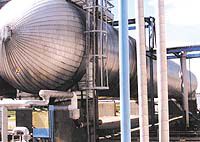| One of two tanks that Pure CO2 purchased in Illinois sits at it’s old site in Chicago. One of the tanks is presently in Nebraska where it is being hauled by a heavy transport vehicle. |
Seventy years ago an entrepreneur set up a dry ice plant near Wellington utilizing gas from the ground that most people thought was worthless. That plant, that operated until three decades ago, put an monetary punch in an otherwise coal dependent community’s economy.
“The guy that did that was a genius,” said Troy Shelley, part of a partnership that will soon be utilizing that same gas to provide the impetus for all kinds of new industries in the area. “He took something no one wanted and made it worthwhile.”
The dry ice that came from that Wellington plant was shipped to many different places, but there was one problem. The dry ice was yellow instead of white, largely because of the sulfur contained in the gas that was used to make the ice. Consequently, as more and more white dry ice came on the market, the product began to suffer and soon the plant closed.
Today the gases that produced that dry ice are still there; embedded in rock far below the surface of the earth. In fact the deposit of the specialty gases involved in the present project are projected to be the third largest deposit in the United States, rivaled only by one in the southwest and in the Midwest. The fact it was so large, however, was actually only discovered by chance.
Shelly and some partners were involved with a natural gas well that was being drilled just west of Sunnyside Junction a few years ago, when the rig hit what at the time was thought to be unusable gas and everyone thought the well was a bust. They were downhearted, thinking money invested had literally gone down a hole.
But upon identifying the substances that were coming out of the well, some research showed that the gases were not only something that could be used for a number of purposes, but that there was a very large market for them. Thus was born the company Pure CO2.
Over the past few months a building has risen just west of the Banning Loadout and equipment to process the gas that will come out of the well has been installed. What the company is waiting for now are two big tanks that will store the refined gases so that it can be loaded onto trucks for transport to an already arranged buyer.
“We are getting close to opening this plant,” said Shelly as he watched a rented track hoe dig a trench for a power line at the site. “The storage tanks and getting them here have been a big problem.”
| A track hoe digs a trench for an electrical line at the new plant near Banning Loadout. |
To build the huge tanks in place would cost the company a million dollars. But the idea of spending the money to build such tanks seems to be a silly proposition considering that two tanks, exactly as needed, were sitting on the shores of Lake Michigan in Chicago, Ill. So Shelly bought the tanks for a fraction of the price of new ones. He had been assured bringing the tanks to Utah would be no problem. However the estimated weight of the tanks was a much lower figure that he reality of their weight. Instead of a weight factor hovering around 200,000 pounds, when loaded on heavy haul equipment, the total weight of each tank alone was 275,000 when all was said and done. And when the transport company started to check out the permitting process for hauling such a large and heavy load 1500 miles, they found thatColorado didn’t want that weight on their roads, nor did anyone wanting the convoys passing through Eisenhower Tunnel on I-70 on their way west.
“So we are going to have to ship them over a northern route,” said the Sanpete County native. “That means I-80 through Wyoming.”
But they also have to take another detour, one most people wouldn’t think would be needed or advisable. Instead of heading into the Wastach Front and coming through Spanish Fork Canyon, the tanks will instead be routed off at Kimball Junction, onto U.S. 40, up Daniels Canyon and into Duchesne. They will be hauled over Indian Canyon/Willow Creek Canyon to U.S. 6 and onto Sunnyside Junction. That trek is supposed to take 12-15 days for each tank, because the equipment to do both at once is not available. It also isn’t cheap, but still much less expensive than building new tanks.
On Wednesday morning Shelley reported that the first tank is presently being hauled across Nebraska and withstanding no equipment breakdowns or weather problems should arrive in Carbon County next week.
When the plant opens, in of itself it will only employ a handful of workers. However a number of truck drivers will be needed to transport the gas to market. In addition, as expansion takes place the plant will be able to produce more and more gas throughout the years.
“We figure at top production rates the source won’t run out of gas for well over a century,” explained Shelly. “And our production can grow, so just possibly some side industries will spring up around here that use our products.”
Some of those kinds of industries include possible cold food packing plants, industrial sites and maybe the most probable, large greenhouses raising plants and vegetables.
Regardless the company hopes to have the plant up and running by late this spring.
“There are a lot of people interested in what we are doing out here and the future for our product looks bright,” concluded Shelley.

